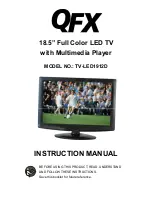
8
English
S-Video Input (VIDEO1), PAGE 10 -
To enhance
video detail use the S-Video jack instead of the Video
jack, if available on your external equipment. (An
S-Video connection will override a connection to the
Video1 input jack.
Composite video Input VIDEO1 or VIDEO2,PAGE
10 -
Standard (composite) video and standard audio
inputs, and for use with video devices with analog
audio and composite video output.Connect digital
video equipment to the Video Yellow jack, and
matching Audio White (L) and Red (R) jacks.
Component Video Input VIDEO3 (YPbPr), PAGE
10
- Connect digital video equipment to the Video
Green (Y), Blue (Pb), Red (Pr) jacks, and matching
Audio White (L) and Red (R) jacks. These jacks
will automatically detect the type of signal being
received.
Digital Audio Output (Coaxial), PAGE 12 -
Use
a Phono-Type (Coaxial) Digital Audio Out Cable to
connect Digital Audio Output to an advanced stereo
home theater system equipped with Dolby® Digital.
Analog / Digital Antenna Input, PAGE 7 -
Connect
an RF antenna or Analog Cable system to this jack.
GETTING STARTED-CONTROLS AND JACKS
LEFT-SIDE
PANEL
BACK-SIDE
PANEL
HDMI Input (INPUT1, INPUT2 or INPUT3),
PAGE 12 -
A digital AV interface that accepts
uncompressed video signals for the best picture.
This HDMI input supports HDCP copy protection,
allowing transmission of copy-protected digital
contents.
PC AUDIO INPUT, PAGE 12, 20 -
This terminal is
not only use for PC audio input but also can share
with
HDMI
audio input for
DVI
signal connecting.
PC INPUT (RGB connector of 15 pin D-SUB),
PAGE 13 -
Connect computer to this terminal. Audio
is separated from another Stereo Mini Jack (PC
AUDIO INPUT).
Stereo Audio Out (L/R) Jacks, PAGE 12 -
Connect
stereo audio equipment to these jacks.
USB port, PAGE 24 -
Used for updating the
television’s firmware and access JPEG file.









































